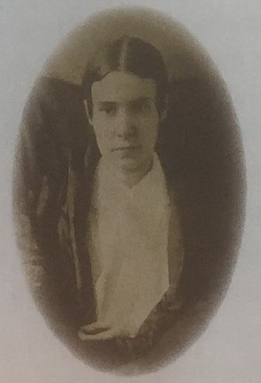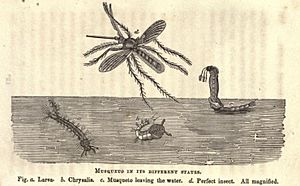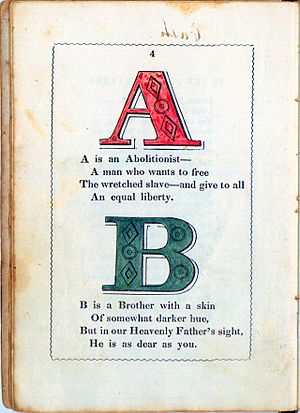Mary Townsend (entomologist) facts for kids
Quick facts for kids
Mary Townsend
|
|
|---|---|

Townsend, date unspecified
|
|
| Born | May 14, 1814 Philadelphia, Pennsylvania
|
| Died | July 8, 1851 (aged 37) Philadelphia, Pennsylvania
|
| Occupation | Writer |
| Years active | 1844-1851 |
Mary Townsend (May 14, 1814 – July 8, 1851) was an American writer who focused on science and was also an abolitionist. An abolitionist was someone who worked to end slavery.
Mary grew up in a well-known Quaker family in Philadelphia. Quakers are a religious group known for their peaceful beliefs and commitment to equality. Mary, her parents, and her brothers and sisters all went to the Westtown School.
From a young age, Mary was very interested in insects. She loved to study them, looking at them closely with a microscope and watching how they behaved. Even when she had health problems and lost her eyesight, Mary found a way to write. She taught herself to write using a special card, similar to braille.
In 1844, she published a popular book called Life in the Insect World: or, Conversations upon Insects, between an Aunt and Her Nieces. This book encouraged many other women to study science.
Mary also worked with her sister Hannah to write The Anti-Slavery Alphabet, published in 1846. This book was for kids. It taught them the alphabet using words that helped them understand human rights and the fight against slavery. The book was sold at anti-slavery events to raise money for the movement. Before she died in 1851, Mary was also working on a history of England for children, written in rhymes, but it was never published.
Contents
Early Life and Education
Mary Townsend was born on May 14, 1814, in Philadelphia, Pennsylvania. Her parents were Priscilla (who was born Kirk) and Charles Townsend. Both of her parents were Quakers and had attended Westtown School. Charles was a druggist and watchmaker.
The Townsend family lived in Philadelphia and were well-educated. They were not super rich, but they were respected in their community. In 1827, their Quaker group split, and Mary's family joined the new branch called the Hicksites. Even though her parents were quietists (meaning they preferred a simple, quiet religious life), they supported their children getting involved in social reform.
Mary often got sick and had to stay in bed. She also eventually lost her eyesight. But this didn't stop her from learning to write using a special "indented card." From a young age, she was fascinated by insects.
The Townsend daughters, including Mary, became active in the anti-slavery movement. They were inspired by people like Lucretia Mott, who also attended their Quaker meeting. Mary became close friends with Graceanna Lewis, and they wrote many letters to each other.
Mary's Books and Career
While she was recovering from an illness, Mary wrote Life in the Insect World in 1844. The book was published without her name on it at first. However, her friend Graceanna Lewis later told others that Mary was the author. Lewis even said that Mary's book inspired her to study nature too.
Mary's book described common insects like ants, bees, butterflies, and spiders. It had twenty chapters and explained things like how ants live together and how butterflies change during their lives. The book also had drawings, which showed that Mary used microscopes to study insects. She also read books by other entomologists (people who study insects) and did her own experiments, like watching what insects ate and the sounds they made.
In 1846, Mary and her older sister Hannah published The Anti-Slavery Alphabet. They wrote it for the Philadelphia Female Anti-Slavery Society's fair. The book was first published anonymously, but their names were later revealed in The Liberator, an anti-slavery newspaper.
This book taught children that they could help the abolition movement. For example, they could teach their friends about slavery or avoid buying goods made by enslaved people. The book helped children understand human rights. Each letter of the alphabet was linked to a word about slavery. For instance, "A" was for "abolitionist," and "B" was for "brothers," reminding readers that enslaved people were part of the human family. The book was reprinted in 1847 and sold at anti-slavery fairs to raise money.
Towards the end of her life, Mary was working on a children's book about England's history, written in rhymes. A writer named Fredrika Bremer visited Mary between 1847 and 1851. Bremer noted that even though Mary couldn't read or write because of her eye problems, she could still tell someone what to write down.
Death and Legacy
Mary Townsend passed away on July 8, 1851, in Philadelphia. She was buried in Woodlands, where her sister Hannah would also be buried soon after.
Mary's book about insects was very important. It inspired Graceanna Lewis and was praised by the Swedish writer Fredrika Bremer. Bremer said the book was written in a way that would encourage girls to study insects.
For a long time, Mary's achievements were not widely known. However, Elizabeth Wagner Reed later wrote a book called American Women in Science before the Civil War. This book helped bring attention back to Mary and other American women who published scientific works before the Civil War.
Mary's family papers are still privately owned. But a family member, Dana Dunbar Howe, has published some of their writings. The third volume, published in 2018, includes some of Mary's papers.
Selected works
- Life in the Insect World: or, Conversations upon Insects, between an Aunt and Her Nieces (1844)
- The Anti-Slavery Alphabet (with Hannah Townsend, 1846) (revised, 1847)
Images for kids






